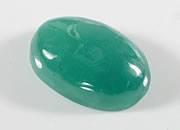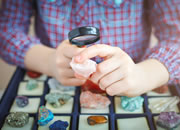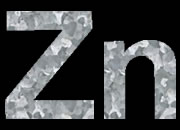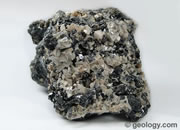Home » Minerals » Hemimorphite
Hemimorphite
A zinc silicate mineral and a minor ore of zinc.
Article by: Hobart M. King, PhD
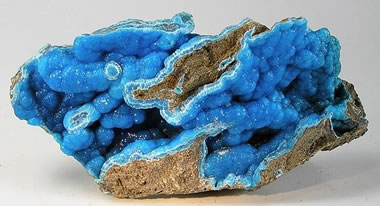
Blue Hemimorphite: Botryoidal hemimorphite crystals with a spectacular blue color completely coating the walls of a pocket. Specimen from the Wenshan Mine, Dulong ore field, Wenshan Autonomous Prefecture, Yunnan Province, China. The specimen measures 12.4 x 6.8 x 3.1 centimeters. Specimen and photo by Arkenstone / www.iRocks.com.
What Is Hemimorphite?
Hemimorphite is a zinc silicate mineral with a chemical composition of Zn4Si2O7(OH)2*H2O. It contains up to 54% zinc by weight and is a minor ore of zinc. Hemimorphite is a common secondary mineral found in the weathered rocks above and around zinc deposits.
Most hemimorphite is white, gray, colorless, or brown. Rare specimens with nice crystals and spectacular yellow, bluish green, or bright blue colors are popular with mineral collectors. It is also cut into cabochons and beads for gemstone collectors and jewelry.
Table of Contents
 What Is Hemimorphite? What Is Hemimorphite? Origin of the Name Hemimorphite Origin of the Name Hemimorphite Geologic Occurrence Geologic Occurrence Physical Properties Physical Properties Crystal Habit Crystal Habit Gemology Gemology Hemimorphite vs Smithsonite Hemimorphite vs Smithsonite |
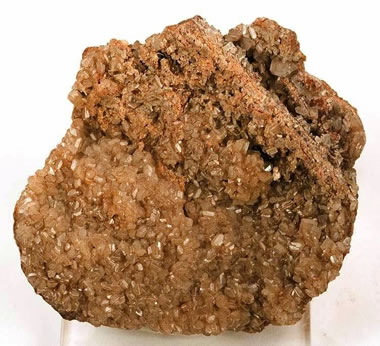
Hemimorphite Crystals on Limestone: Brown crystals of hemimorphite encrusting limestone from the Granby Field, Tri-State District, Newton County, Missouri. The specimen measures 7.2 x 6.6 x 2.5 centimeters. Specimen and photo by Arkenstone / www.iRocks.com.
Origin of the Name Hemimorphite
The word hemimorphic is an adjective used to describe a crystal that has terminations of different shapes at the end of its primary crystallographic axis. Adolph Kenngott knew that hemimorphite was one of just a few minerals that produced hemimorphic crystals. That inspired him to use the name hemimorphite in 1853.
Prior to Kenngott's use of the name, hemimorphite and smithsonite were both called "calamine". In 1962 the International Mineralogical Association chose to use the name hemimorphite for the mineral. [1]
Geologic Occurrence of Hemimorphite
Most hemimorphite is found in the rocks above and surrounding zinc deposits. Here, primary zinc ores such as sphalerite were altered to produce hemimorphite as a weathering product, or secondary mineral. Some hemimorphite is also formed where zinc-bearing rocks were subjected to metasomatism.
Hemimorphite can occur as crusts that replaced primary sulfide minerals, crusts of crystals that covered the surfaces of fractures and cavities, or massive to granular aggregates of crystals that fill cavities and replace host rocks. The crystals that produce spectacular mineral specimens are often the last-to-form crystals that grow unobstructed, outward into a subsurface cavity.
Physical Properties of Hemimorphite |
|
| Chemical Classification | Silicate |
| Color | Usually white, brown, gray, or colorless. Sometimes displays spectacular blue, greenish blue, or green colors. Beautiful color and interesting crystal habits make hemimorphite popular with mineral collectors. |
| Streak | White |
| Luster | Vitreous to pearly |
| Diaphaneity | Translucent to semi-transparent |
| Cleavage | Perfect on {110}, poor on {101}. Brittle with uneven fracture. |
| Mohs Hardness | 4 1/2 to 5 |
| Specific Gravity | 3.4 to 3.5 |
| Diagnostic Properties | Crystal habit, hardness, specific gravity |
| Chemical Composition | Zn4Si2O7(OH)2*H2O |
| Crystal System | Orthorhombic |
| Uses | An ore of zinc. Specimens are popular with mineral collectors. Sometimes cut into gems for collectors. |
Physical Properties of Hemimorphite
If you attend a mineral show or visit a museum, you will see hemimorphite specimens with beautiful crystals and in spectacular colors. Most hemimorphite has an unremarkable appearance. It usually occurs in a massive or granular habit and is white, gray, colorless or brown in color.
Individual crystals, when distinguishable, can be prismatic, tabular and asymmetric. When hemimorphite crystals grows into an unfilled cavity they often develop into a botryoidal habit or into a druse that covers the walls of the cavity. Associated minerals include: smithsonite, sphalerite, cerussite, anglesite, and galena.
Diagnostic properties in hand specimens are its crystal habit, hardness, specific gravity, and its effervescence with cold hydrochloric acid.
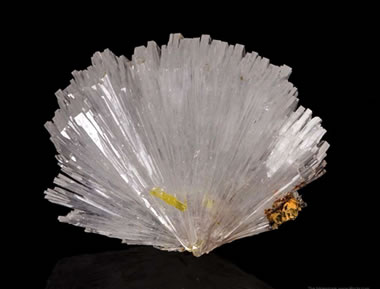
Hemimorphite Crystal Cluster: A fan-shaped spray of colorless hemimorphite crystals in a radial habit. Specimen is from the Ojuela Mine, Mapimi, Durango, Mexico, and measures 2.8 x 2.4 x 1.0 centimeters. Specimen and photo by Arkenstone / www.iRocks.com.
Crystal Habit
Hemimorphite exhibits a variety of crystal habits, including prismatic, tabular, and botryoidal. The crystals are often blade shaped and grow in clusters. These clusters can form a fan-like spray of blade-shaped crystals; a cockscomb similar to marcasite; or, tightly intergrown, radiating clusters that produce a botryoidal habit.
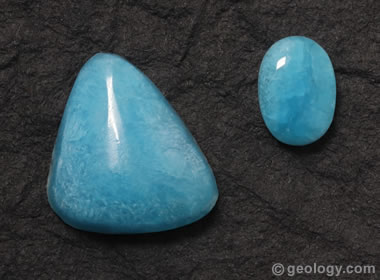
Blue Hemimorphite Cabochons: Two cabochons of hemimorphite with a wonderful blue color. The triangular cab measures 18 x 16 millimeters, and the small oval cab measures 11 x 8 millimeters.
Gemology
Hemimorphite is a favorite collector gem because it occurs in a range of spectacular colors. Some collectors seek out specimens that will cover the full range of hemimorphite's colors.
Hemimorphite should be used cautiously in jewelry. It has a Mohs hardness of only 4 ½ to 5, so it will be quickly abraded if worn in a ring or bracelet. It is brittle and has perfect cleavage, so it will break easily upon impact.
Because hemimorphite is fragile, its use in jewelry is best limited to earrings, pins, pendants, and other pieces that are unlikely to experience impact or abrasion. When stored, hemimorphite jewelry should be placed in cushioned boxes, bags, or jewelry box compartments where two pieces of jewelry will not rub against one another.
Specimens with spectacular colors can cause excitement. The Gemological Institute of America's lab received a translucent electric blue cabochon of 5.61 carats with a request to perform a Paraiba tourmaline origin report. The gem exhibited some properties that were consistent with Paraiba tourmaline, but testing revealed that it was hemimorphite with a Paraiba-like color. [2]
More from Geology.com
Hemimorphite vs. Smithsonite
Although hemimorphite and smithsonite are different minerals with different chemical compositions and crystal structures, they have frequently been confused - especially when only simple tools were available and the specimens could not be subjected to destructive testing. Often a single specimen will be an intergrown mixture of hemimorphite and smithsonite. Until the mid-to-late 1800s, the name "calamine" was used for both minerals.
| Hemimorphite Information |
|
[1] Hemimorphite: a mineral page on the mindat.org website, accessed December 2020.
[2] Hemimorphite Resembling Paraiba Tourmaline: by Sudarat Saeseaw, Gems & Gemology, Volume 56, Number 2, pages 285 to 286, Summer 2020. |
A few properties can help prevent confusion. Hemimorphite has a lower specific gravity (3.4 to 3.5) than smithsonite (4.3 to 4.5). Hemimorphite will not react with hydrochloric acid, but smithsonite will effervesce in contact with cold hydrochloric acid - but remember that the two minerals are often intergrown in a single specimen. Hemimorphite has perfect cleavage in one direction, but smithsonite has perfect cleavage in two directions which meet to form rhombic shapes.
| More Minerals |
 |
Herkimer Diamonds |
 |
The Acid Test |
 |
Tumbled Stones |
 |
Zircon |
 |
Fool*s Gold |
 |
Kyanite |
 |
Rock Tumblers |
 |
Rhodochrosite |

Find Other Topics on Geology.com:

|

| ||

|

| ||

|

| ||

|

|

